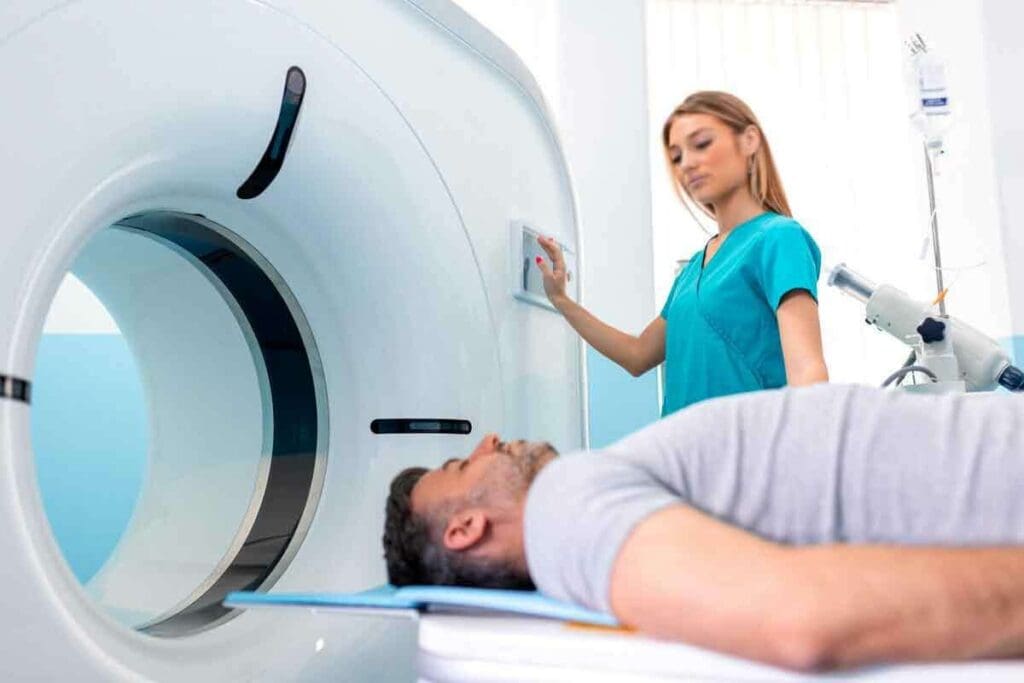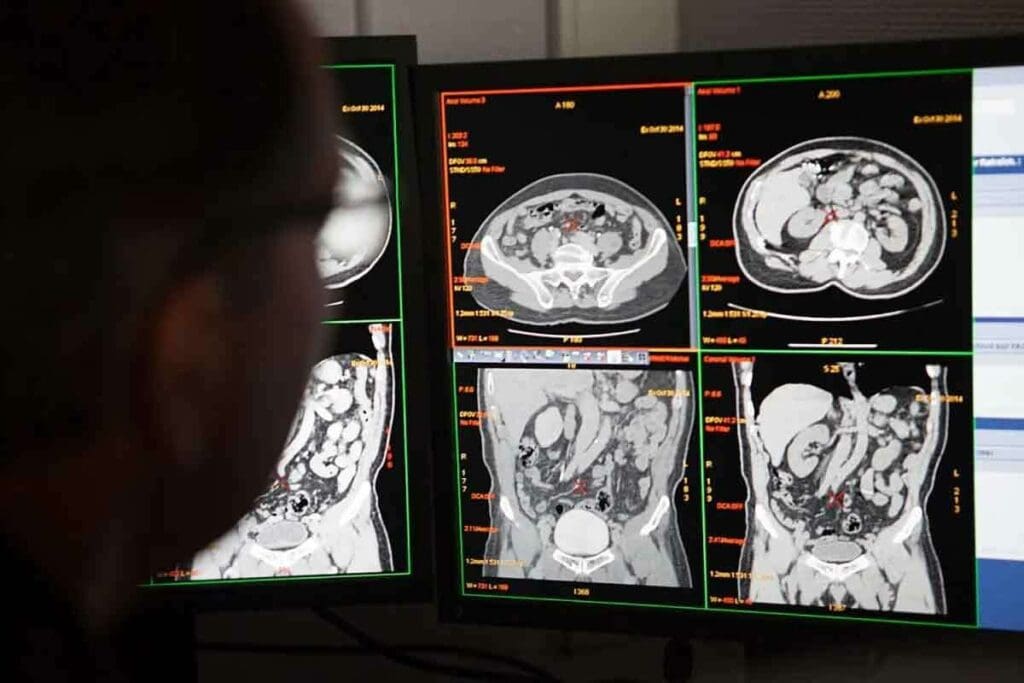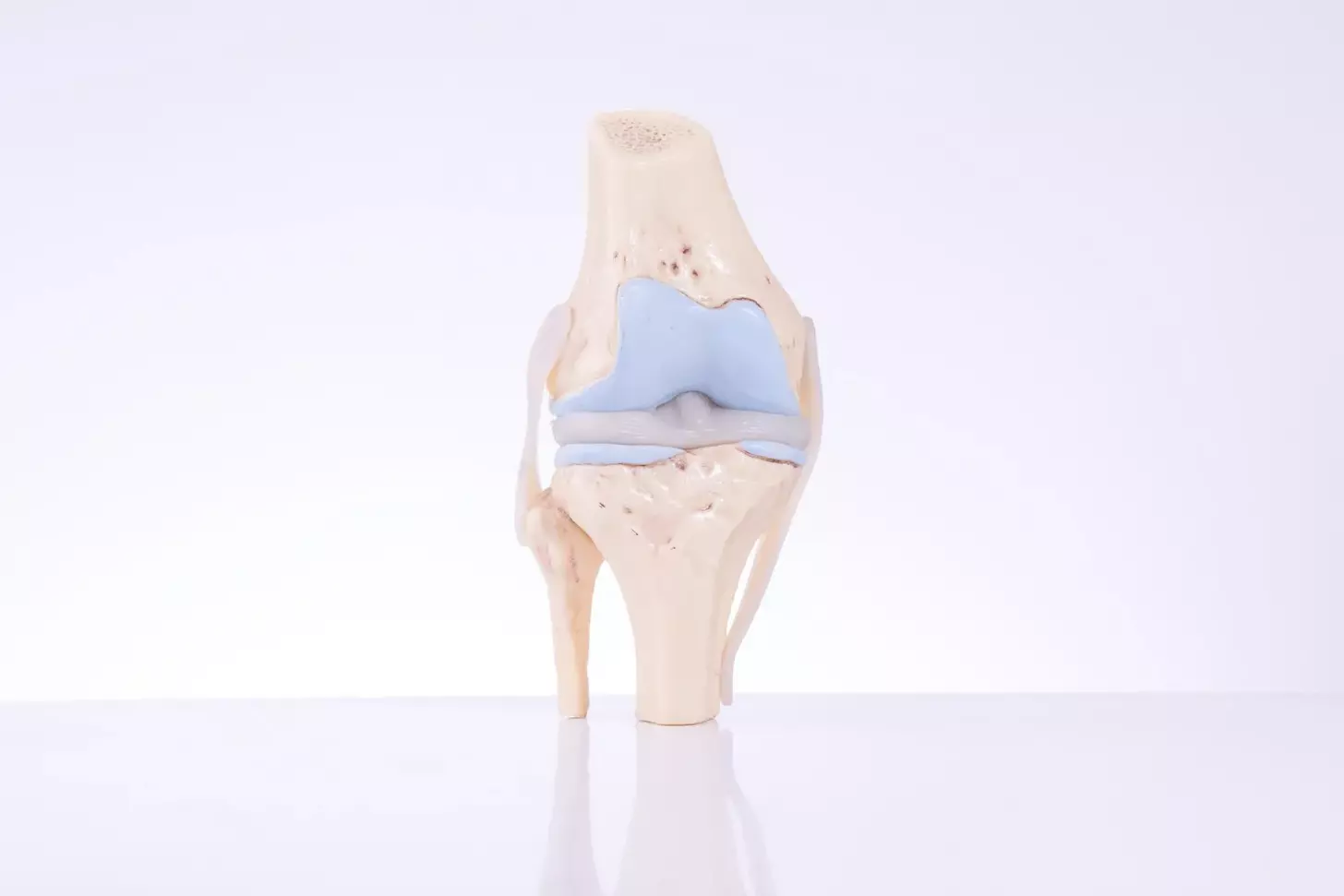Last Updated on November 27, 2025 by Bilal Hasdemir

When symptoms in the abdomen are puzzling, a CT scan is often a key tool. It’s quick, doesn’t hurt, and is very accurate. At Liv Hospital, we use top-notch methods and focus on our patients. This means every step is made to be both precise and comfortable for you.Understand the CT scan time frame with our ultimate guide. Get powerful insights into the duration of an abdomen scan and its amazing findings.
Knowing how long a CT scan of the abdomen takes and what it shows is important. A CT scan of the abdomen usually takes about 30 minutes from start to finish. The actual scan itself is usually done in 10 minutes or less.
Key Takeaways
- A CT scan uses X-rays to make detailed pictures of structures inside the body.
- It’s used to diagnose various abdominal conditions.
- The entire process typically takes around 30 minutes.
- The actual scanning process is usually 10 minutes or less.
- At Liv Hospital, we follow internationally benchmarked protocols for accuracy and comfort.
Understanding Abdominal CT Scans

A CT scan of the abdomen is a high-tech way for doctors to find out what’s wrong. It shows the inside of the abdomen, like the liver, pancreas, and kidneys. This helps doctors see problems that might not show up on other scans.
These scans are great because they give clear, detailed pictures. They take many X-ray images from different sides. Then, they put all these images together to make a complete picture.
What is a CT Scan of the Abdomen?
A CT scan of the abdomen is a safe test that uses X-rays and computers to make detailed pictures. It’s key for spotting many health issues, like injuries, cancers, infections, and blood vessel problems.
The CT scanner is a big, ring-shaped machine. It moves around the patient, taking pictures from all sides. These pictures help doctors check the health of the abdominal organs and find any issues.
How CT Technology Creates Detailed Images
CT technology makes detailed images by combining X-rays from different angles. These X-rays are then turned into detailed pictures using advanced computer programs.
The images are very clear, showing the inside of the abdomen in great detail. This clarity is vital for doctors to make accurate diagnoses and plan the best treatments.
The CT Scan Time Frame: From Check-in to Completion

Knowing how long a CT scan of the abdomen takes is key to planning your day. The process includes several steps. These are from check-in and getting ready for the actual scan, and sometimes contrast dye.
Average Total Duration
A CT scan of the abdomen usually takes about 30 minutes. This includes check-in, getting ready, and the scan itself.
Factors That May Extend Scan Time
Several things can make the scan last longer, up to 60 minutes. These include:
- Using contrast dye, which needs extra prep and watching.
- Scans that need more detailed images or extra sequences.
- Things specific to the patient, like extra positioning or special scanning methods.
| Component | Average Time |
| Check-in and Preparation | 15 minutes |
| Actual Scanning | 5-10 minutes |
| Contrast Dye Administration | 5-10 minutes |
| Total Time without Contrast | 20-25 minutes |
| Total Time with Contrast | 30-60 minutes |
The Actual Scanning Process Duration
An abdominal CT scan takes about 10 minutes or less. This quick time is a big plus. It helps doctors make fast diagnoses and plans for treatment.
10-Minute Active Scanning Time
The time the CT machine captures images is called active scanning. It usually takes 10 minutes. The patient must stay very quiet and not move on the scanning table.
Doctors say CT scans are great for people who can’t stay calm for long. This is because they’re fast. It also means less chance of blurry images from movement.
What Happens During the Scan Procedure
The table moves into the CT machine, and X-rays are taken. Patients must stay very quiet and might need to hold their breath. The CT technician works from another room, talking to the patient through an intercom.
Staying perfectly quiet is key to clear images. The technician will tell you when to hold your breath. This helps get the best images for doctors to look at.
The whole process is made to be easy and quick. Even though the scan itself is short, the whole visit might take longer. But the fast scan is a big help for diagnosing many abdominal problems.
Preparation Requirements for an Abdominal CT Scan
Before your abdominal CT scan, knowing what to do is key. It helps get clear images for your doctor’s diagnosis. Follow these steps for a smooth procedure.
Fasting Guidelines Before Your Appointment
Your doctor will tell you how long to fast before the scan. You’ll need to avoid eating and drinking for a few hours. The fasting time depends on your scan and health.
Following these fasting instructions is very important. It helps get clear images of your organs. This is because it keeps your intestines from moving too much.
Clothing and Accessory Recommendations
Wear comfy, loose clothes for your scan. You might need to change into a hospital gown. Avoid metal jewelry to prevent scan issues or safety risks.
- Remove any metal objects such as belts, jewelry, or glasses.
- Leave valuables at home.
- Be prepared to change into a hospital gown if required.
Hydration Instructions
Even though you might fast, drinking water is okay. Your doctor will tell you how much to drink. Staying hydrated helps with the scan and keeps you comfortable.
Medical History Information to Provide
Tell your doctor about your medical history, including allergies and medications. This info helps your doctor prepare for your scan safely.
Be ready to share your medical history in detail. Your doctor will use this to make your scan safe and effective.
By following these steps, you help make your CT scan safe and successful. This ensures the best results for your health.
What Abdominal Organs Can a CT Scan Visualize?
A CT scan of the abdomen is a powerful tool for seeing many organs inside. It gives detailed pictures of the abdominal area. This helps doctors find and track many health issues in the organs.
Liver and Gallbladder Imaging
The liver and gallbladder are key organs that CT scans can show well. The liver’s shape and any problems like tumors or cysts are clear. The gallbladder, which holds bile, can be checked for gallstones or swelling. For more info, check RadiologyInfo.org.
Pancreas and Spleen Visualization
The pancreas, important for digestion and blood sugar, can be seen with a CT scan. It helps find issues like pancreatitis or tumors. The spleen, vital for the immune system, can also be checked for problems like swelling or rupture.
Kidneys and Adrenal Glands Assessment
A CT scan shows the kidneys in detail. It helps diagnose problems like stones, cysts, or tumors. The adrenal glands, above the kidneys, can also be seen. This allows for finding tumors there.
Intestines and Bladder Examination
The intestines, both small and large, can be looked at with a CT scan. It helps find issues like blockages, inflammation, or tumors. The bladder, part of the urinary system, can also be checked for problems like stones or tumors.
| Organ | Common Conditions Diagnosed |
| Liver | Tumors, cysts, fatty liver disease |
| Pancreas | Pancreatitis, pancreatic cancer |
| Kidneys | Kidney stones, cysts, tumors |
| Intestines | Bowel obstruction, inflammation, tumors |
| Bladder | Bladder stones, tumors |
Does a CT Scan of the Abdomen Show the Lungs?
The abdominal CT scan is a useful tool for diagnosing, but it has its limits. It mainly looks at the organs in the abdomen. But it might also show parts of the lower lungs.
Limited Lung Visibility in Standard Abdominal Scans
A standard CT scan of the abdomen is not made for detailed lung views. But, he upper parts of the scan might show some of the lower lung lobes. This means:
- Small lung nodules or issues might not be seen.
- The lung’s structure and diseases might not be fully checked.
- People with lung problems might need special lung scans.
When Combined Chest and Abdominal Scans Are Necessary
In some cases, a CT scan of both the chest and abdomen is suggested. This is helpful when:
- Patients have symptoms that could be in the chest or abdomen.
- When cancer needs to be staged, as it can affect both areas.
- Trauma patients need checks for injuries in both areas.
These combined scans give a better view, helping doctors check more areas at once.
Alternative Imaging for Thoracic Concerns
For lung issues, other scans might be better. These include:
- Chest X-ray: A fast and simple first check.
- Chest CT: Shows detailed lung and surrounding images.
- Positron Emission Tomography (PET) scan: Good for lung tissue activity.
Talking to a healthcare provider is key to finding the right scan for each person.
Common Medical Conditions Diagnosed with Abdominal CT Scans
Abdominal CT scans are key in finding many health issues in the belly area. They show detailed pictures of organs and tissues. This helps doctors spot problems and make accurate diagnoses.
Appendicitis and Inflammatory Bowel Disease
CT scans are great for spotting appendicitis and inflammatory bowel disease (IBD). They show if the appendix is swollen and any problems it might have. For IBD, like Crohn’s disease and ulcerative colitis, they check how bad the inflammation is.
Accurate diagnosis is key to the right treatment. This can be medicine or surgery.
Kidney Stones and Urinary Tract Issues
CT scans are also good for finding kidney stones and urinary tract problems. They show how big, where, and how many stones are. This helps doctors choose the best treatment.
CT scans help manage urinary tract issues better. They lead to more targeted and effective treatments.
Abdominal Cancers and Tumors
CT scans help find and check for belly cancers and tumors. They show how big, where, and if it has spread. This info is key for planning treatment, like surgery or chemo.
- Liver cancer
- Pancreatic cancer
- Lymphoma
These are some belly cancers that CT scans can spot and keep an eye on.
Infections, Abscesses, and Inflammation
CT scans can also find infections, abscesses, and inflammation in the belly. They spot pus collections and inflammation. This helps doctors pick the right treatment, like antibiotics or draining.
CT scans give clear and detailed images of complex belly issues. They are a vital tool in medicine.
Contrast vs. Non-Contrast Abdominal CT Scans
Knowing the difference between contrast and non-contrast abdominal CT scans is key to accurate diagnosis. CT scans help us see the abdominal organs and find various conditions. But using contrast dye can change how we diagnose.
When Contrast Dye Is Recommended
Contrast dye is used when we need to see specific areas or structures in the abdomen. It’s great for spotting blood vessels, tumors, and injuries. The dye makes these structures clearer, helping us make more accurate diagnoses.
For example, contrast dye helps us tell apart tumors or abscesses from healthy tissue. A study in the Journal of Clinical Imaging found contrast-enhanced CT scans improved tumor detection by up to 30%.
“The use of contrast agents in CT scans has revolutionized the field of diagnostic imaging, enabling healthcare professionals to detect and diagnose conditions more accurately.”
Radiological Society of North America
How Contrast Administration Affects Scan Duration
Using contrast dye can make the CT scan take longer. The scan itself is about 10 minutes, but adding contrast makes it longer. We need time to give the dye, usually through an IV, before scanning.
| Procedure | Non-Contrast CT | Contrast-Enhanced CT |
| Preparation Time | 10-15 minutes | 20-30 minutes |
| Scanning Time | 10 minutes | 10-15 minutes |
| Total Time | 20-25 minutes | 30-45 minutes |
Potential Reactions and Safety Precautions
Contrast dye is usually safe, but there can be reactions. Mild reactions include hives or itching. Severe reactions, like anaphylaxis, are rare but serious. We watch patients closely during and after dye administration.
We check patients’ medical history and current health before dye use. Those with kidney disease or allergies may need special care or other imaging.
Contraindications for Contrast Use
There are times when we can’t use contrast dye. Patients with severe kidney disease or who are pregnant or breastfeeding should avoid it. We also consider other imaging for those with dye allergies or severe reactions.
In summary, choosing to use contrast dye in CT scans depends on many factors. These include the patient’s health, the needed diagnosis, and possible risks. Understanding contrast-enhanced CT scans helps us give better diagnoses and treatment plans.
CT Scans Compared to Other Abdominal Imaging Methods
CT scans are known for their speed and accuracy in abdominal imaging. But how do they stack up against other diagnostic tools? We’ll look at the good and bad of CT scans compared to common imaging methods.
CT Scans vs. Ultrasound
Ultrasound is great because it doesn’t use radiation and shows images in real-time. But it depends a lot on the person doing the scan. It might not show as much detail as CT scans for some issues.
CT scans give more detailed images of the inside of the abdomen. This makes them a preferred diagnostic tool for many serious conditions.
CT Scans vs. MRI
MRI is good for soft tissue images without radiation. But it takes longer than CT scans and might not be as easy to get.
In emergencies, speed and accuracy are key. CT scans are often chosen because they’re quick and give clear images.
When CT Is the Preferred Diagnostic Tool
CT scans are best in emergencies when fast diagnosis is needed. They’re also great for complex abdominal issues that need detailed images.
The speed and accuracy of CT scans are key to making quick decisions in patient care.
Speed and Accuracy Advantages
CT scans are fast and accurate, which is vital in abdominal imaging. Quick diagnosis can greatly improve patient outcomes.
CT scans offer a balance of detail and speed. They are a key part of abdominal imaging, working alongside ultrasound and MRI.
Safety Considerations and Radiation Exposure
It’s important to know about the safety and radiation from CT scans. These scans are useful for diagnosis but do involve radiation.
Understanding Radiation Dose in CT Scanning
Children and pregnant women should be careful about CT scan radiation. We use the least amount of radiation needed for a good diagnosis. An abdominal CT scan usually has a dose of a few hundred mGy*cm.
Radiation dose management is key to lowering exposure. Scanners adjust the dose based on the patient’s size and the scanned area.
Risk vs. Benefit Assessment
We look at the risks and benefits of CT scans. The benefits often outweigh the risks, helping guide treatment. But, we also consider non-radiation options like ultrasound or MRI.
Special Considerations for Pregnant Patients
Pregnant women need extra care with radiation. We try to keep radiation low. We talk about risks and benefits and look for other imaging options.
Technological Advances Reducing Radiation Exposure
New CT scanner tech aims to lower radiation. They use better algorithms and dose control to keep images clear while reducing dose. We keep our tech and methods up to date for safety.
We work hard to make CT scans safe and effective. Our goal is to use the least radiation needed for a good diagnosis. This shows our dedication to safety in CT scanning.
Conclusion: Understanding the Efficiency and Value of Abdominal CT Scans
We’ve looked into abdominal CT scans, from getting ready to the scan itself. They give detailed images that help doctors diagnose and plan treatments. These scans are key in healthcare, showing the insides of the abdomen clearly.
CT scans are quick, lasting from 30 to 60 minutes. The actual scan is just 10 minutes. Their speed and detailed images make them vital in healthcare today.
Knowing how CT scans work helps patients see their importance. They show the inside of the abdomen in great detail. This helps doctors find and treat problems accurately.
FAQ
How long does a CT scan of the abdomen take?
A CT scan of the abdomen usually takes 30 to 60 minutes. The actual scan part is about 10 minutes.
What is the purpose of a CT scan of the abdomen?
It helps find and track many abdominal problems. This includes injuries, cancers, and infections. It does this by making detailed pictures of the organs inside.
Does a CT scan of the abdomen show the lungs?
A standard CT scan of the abdomen might show a bit of the lungs. But it’s not made for a full lung check. For lung issues, you might need a chest CT or X-ray.
What preparation is required for an abdominal CT scan?
You might need to fast before the scan. Wear certain clothes and drink water. Also, tell your doctor about your health history to make the scan go smoothly.
What abdominal organs can be visualized through a CT scan?
A CT scan can show many organs. This includes the liver, gallbladder, pancreas, spleen, kidneys, adrenal glands, intestines, and bladder. It helps find problems in these organs.
What is the difference between a contrast and a non-contrast CT scan?
Contrast CT scans use dye to make images clearer. Non-contrast scans don’t. The dye is better for some cases, but might not be safe for everyone.
How does a CT scan compare to other abdominal imaging methods?
CT scans are faster and more accurate than ultrasound and MRI. The best choice depends on the problem and what the patient needs.
What are the safety considerations for CT scans?
CT scans use radiation. While they’re usually safe, it’s important to weigh the benefits against the risks. Pregnant women should be extra careful.
Can CT scans diagnose all abdominal conditions?
CT scans can spot many problems, like appendicitis, inflammatory bowel disease, and cancers. But it depends on the condition and if dye is used.
How long does it take to get the results of a CT scan?
Getting CT scan results can take different times. Sometimes, you might get quick results. Other times, it might take longer for a full report.
References
- RadiologyInfo.org. (2024, March 31). Abdominal and Pelvic CT. Retrieved from https://www.radiologyinfo.org/en/info/abdominct






